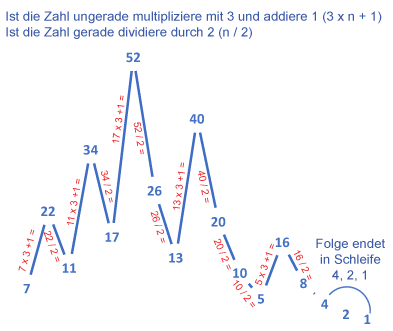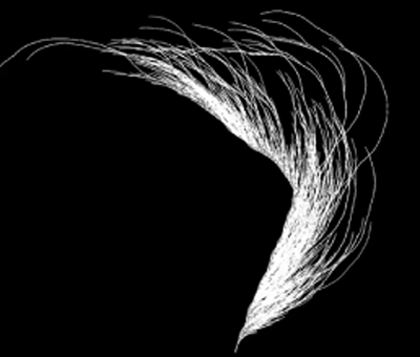| Stomachion | |||||
 |
The 3n+1-Conjecture The 3n+1 conjecture, also known as the Collatz conjecture (named after the German mathematician Lothar Collatz 1910-1990), is the most dangerous problem in mathematics. Mathematics students are warned not to waste their time on it. It is a simple conjecture that has not even been proven by the world's best mathematicians. Paul Erdös (1913-1996), one of the most significant mathematicians of the 20th century, stated that it was "absolutely hopeless" to solve the problem, as mathematics simply was not mature enough for it. The problem involves sequences of numbers constructed according to a simple rule: Start with any natural number n. If n is odd, multiply by 3 and add 1. If n is even, divide the number by 2. Repeat the process with the obtained number. For example, with the starting number n = 7, the sequence as depicted in the diagram below is obtained. Eventually, the sequence enters a cycle where the numbers 4, 2, 1 are constantly repeated. The conjecture now is: The sequence always ends up in the cycle 4, 2, 1, regardless of the positive natural number with which one begins. This conjecture has neither been proven nor disproven so far. Mathematicians have tested every number up to 295,147,905,179,352,852, and the curve has always ended up in the cycle 4, 2, 1.
It is interesting that each number generates a different curve with varying numbers of steps, and the ups and downs of the curves appear completely random. Between the curves, there are intersection points where the curves pass through the same number. One way to visualize this is the form of a directed graph, which shows how the numbers of the individual sequences are connected. It looks like a tree or a series of rivers all flowing into a single stream. Some mathematicians have modified the graph slightly by rotating the direction arrow counterclockwise by a certain angle for odd numbers and slightly clockwise for even numbers. Then you end up with a structure that looks like coral or a bundle of seaweed or a wild hedge, thus an organically shaped form.
Above: Collatz graph from millions of numbers.
Left: Pins and thread on lightweight board (26.5 x 100 cm). Directed graph showing the connection of numbers 1-1000 in the Collatz conjecture. |

